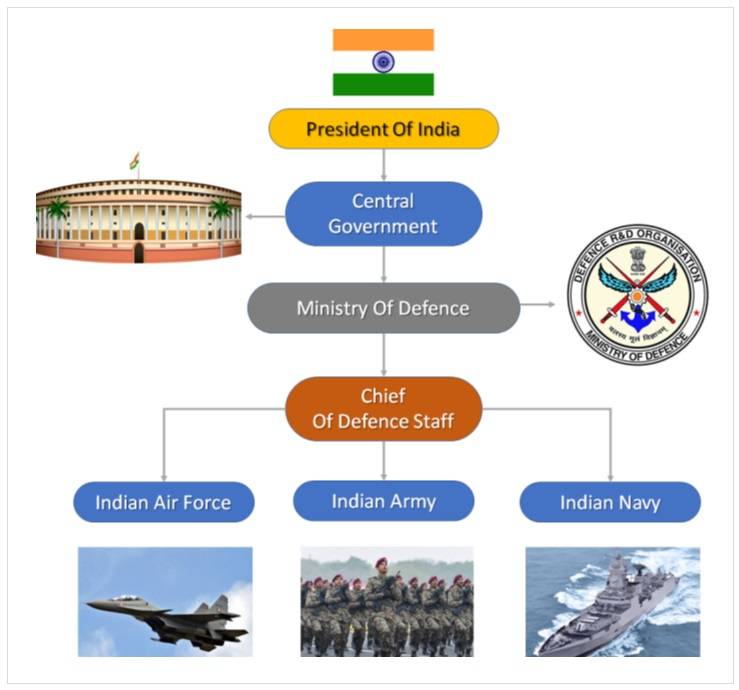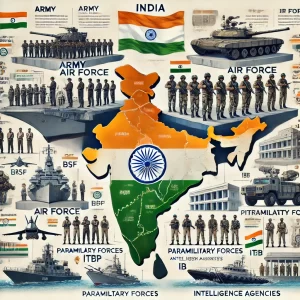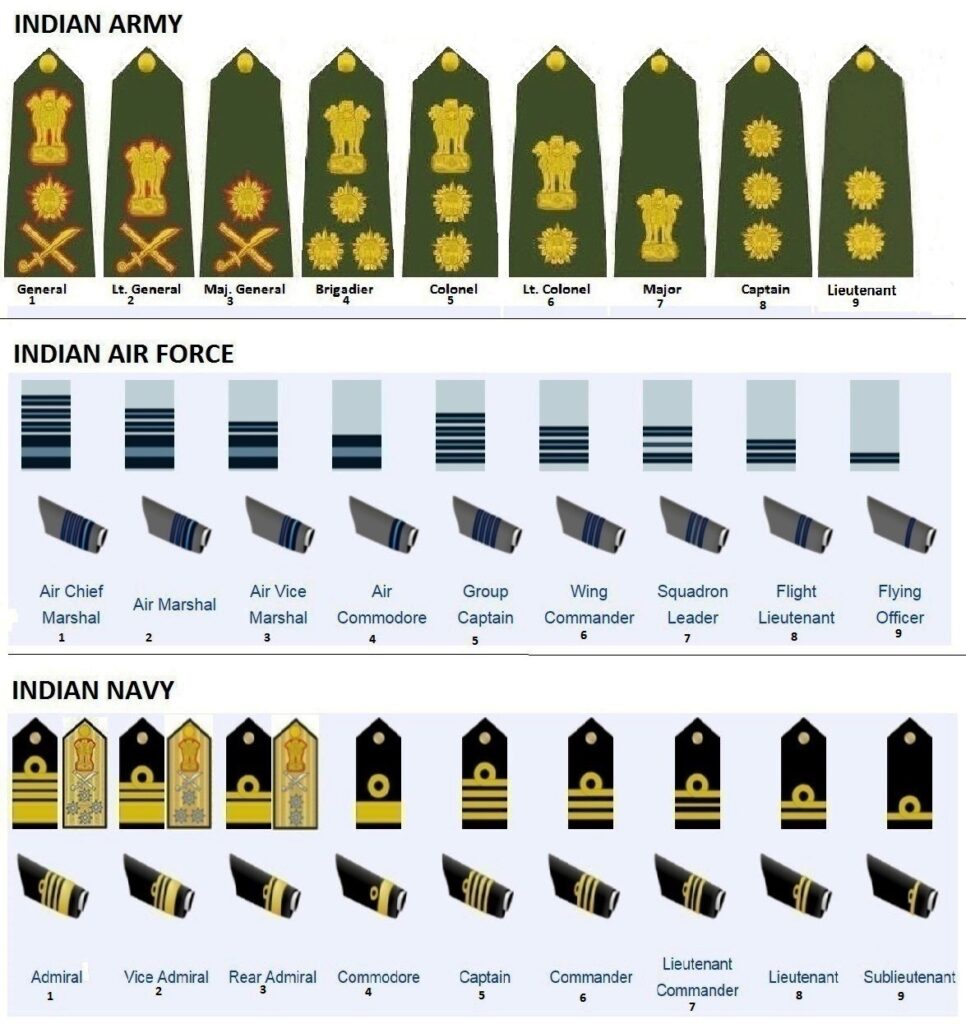By Rahul Essarani
India’s Security Architecture is a sophisticated, multi-tiered framework designed to safeguard the nation from internal and external threats. Given the country’s vast geographical expanse, diverse demographic composition, and complex security challenges, this framework integrates the Indian Armed Forces, Central Armed Police Forces (CAPFs), intelligence agencies, and specialized units. Together, these entities work to preserve India’s sovereignty and ensure internal stability.
A.)The Backbone: Ministry of Home Affairs and Central Armed Police Forces
The Present Architecture consists of political, administrative; intelligence and enforcements personnel are-:
- At Political Level there is Cabinet Committee of Security.
- At Administrative Level or Personnel, the Ministry of Home Affairs, the Prime Minister Office & the Cabinet Secretariat.
- At Intelligence Level authority spread over different ministry one is the Intelligence Bureau which reports to the Home Minister, there is the Research and Analysis Wing which falls under the Cabinet Secretariat and reports to the PM, others organizations such as Joint Intelligence Committee (JIC), National Technical Research Organization (NTRO) and Aviation Research Centre (ARC) which report to the National Security Council Secretariat under the NSA which serves the National Security Council.
- The Armed Forces have their own intelligence agencies one each under the Army, Navy and Air Force and an umbrella body called Defence Intelligence Agency.
Lastly, the Enforcement Level in which the Architecture consists of the central paramilitary force such as CRPF, BSF, CISF, ITBP, ASSAM RIFLES, SSB & NSG. There is other agencies which specialise in financial intelligence. There are the Directorates in the Income Tax, Customs and Central Excise Departments, the financial Intelligence Unit and the Enforcement Directorate.
Under Indian Constitutional Provisions Article 355 of the Constitution enjoins the Union to protect every state against external aggression and internal disturbance and to ensure that the government of every state is carried on accordance with provisions of the Constitution.
The Commander-in-Chief of the Indian Military is the President of India. The Responsibility for National Defence rests with the Cabinet Under the Ministry of Defence.
The Indian Armed Forces Only Military are the second-largest in the world, after the People’s Liberation Army of China and have troops deployed around the world.
The Ministry of Home Affairs (MHA) plays a pivotal role in maintaining internal security. It provides manpower, financial support, and strategic direction to state governments for peace and harmony while respecting their constitutional autonomy. The MHA oversees several departments critical to internal security, such as:
- Department of Border Management: Focused on managing India’s extensive land and coastal borders.
- Department of Internal Security: Handles police operations, law and order, and rehabilitation efforts.
Central Armed Police Forces (CAPFs) The CAPFs which operate under the MHA, include:
- Border Security Force (BSF): Protects India’s borders, combats infiltration, and tackles cross-border terrorism.
- Central Reserve Police Force (CRPF): Manages law and order, counter-insurgency operations, and election security.
- Indo-Tibetan Border Police (ITBP): Secures India’s high-altitude borders with China.
- Central Industrial Security Force (CISF): Guards critical infrastructure such as airports and nuclear plants.
- Sashastra Seema Bal (SSB): Protects India’s borders with Nepal and Bhutan.
- National Security Guard (NSG): An elite counter-terrorism force handling hostage rescue and high-risk operations.

B.)Military Power:
1.)Indian Army
Indian Army which is the land-based system and the largest of the Indian Armed Forces, it is commanded by the Chief of the Army Staff. Indian Army has a regimental system, but is operationally and geographically divided into seven commands with the basic field formation being a division. The primary mission is to ensure national security and unity and protecting the nation from external aggression and threats and maintaining peace and security within its borders especially peace and security within its borders especially insurgent-hit Kashmir and the North-East, it also conducts humanitarian rescue operations during natural calamities and it sometimes helps the government cope with internal threats.
a.) Seven Commands of Indian Army are-:
1.Western Command- Responsible for the security of India’s western border’s including Punjab, Haryana and parts of Rajasthan. The HQ (Head Quarter) are in Chandi Mandir near Chandigarh, having 2,50,000 personnel second-largest command in the Indian Army includes armoured and mechanized forces (Pakistan Borders).
- Eastern Command- Responsible for the security of India’s northeastern borders, including Arunachal Pradesh, Assam, Manipur, Nagaland, Mizoram, Meghalaya, Tripura and parts of Sikkim. HQ are in Fort William in Kolkata, West Bengal, having 2,00,000 personnel third-largest command in Indian Army includes Indian Army’s counter insurgency forces.
- Northern Command- Responsible for the security of India’s northern borders, including Jammu and Kashmir and parts of Himachal Pradesh. The HQ are in Udhampur, Jammu and Kashmir, having 3,00,000 personnel largest in Indian Army includes Indian Army’s elite strike forces such as the Special Frontier and Parachute Regiment (Pakistan and China Borders)
- Southern Command- Responsible for the security of India’s southern borders with Sri Lanka and the Maldives. The HQ are in Pune Maharashtra, having 1,50,000 personnel fourth-largest command in the Indian Army includes the Indian Army’s amphibious and aviation forces.
- Central Command- The Central Command is responsible for the Defence of India’s Central Region. It is the sixth-largest command in the Indian Army, with over 50,000 personnel. HQ at Lucknow (UP) includes the Indian Army’s Rapid Action Forces.
- South-Western Command- It is responsible for the defence of India’s, south western borders with Pakistan Rajasthan. It is the fifth-largest command in the Indian Army, with over 1,00,000 personnel. It includes Indian Army’s desert forces HQ Jaipur.
- Training Command- It is responsible for the training of all Indian Army personnel. It is the smallest command in the Indian Army with over 25000 personnel. The training command also includes the Indian Army’s military academy and training schools HQ Dehradun.
b.) Sub Divisions of the Army are-:
- Section- 10 soldiers make a section.
- Platoon- 3 sections make a platoon headed by a JCO- Junior Commissioned Officer. (3×10= 30)
- Company- Three Platoons make a company headed by a company commander who is a Major or L.T Colonel in Rank. CGO. (30×3= 90)
- Battalion- Four company make a battalion. This is the main fighting unit of infantry and is commanded by Battalion Command in the rank of Colonel. (90×4= 360)
- Brigade- Three Battalions form a Brigade and commanded by Brigade Commander, a Brigadier rank officer. (360×3= 1080)
- Division- Three to four Brigades make up a division headed by a Major General who is termed (Division Commander). The Indian Army today has 37 divisions including Infantry, Mountains, Armoured, Artillery and Re-organised Army Plains Infantry Division or Rapids (1080×4= 4320)
- Corps- Three to four division make up a corps. A Lieutenant General heads the Corps. A Lieutenant General heads the Corps as GOC (Corps Commander). 4320×4= 17,280).
The Various Services under Indian Army are like to provide the logistical arms ammunition rations etc material to the army
Army Service Corps, Army Medical Corps, Army Dental Corps, Army Ordnance Corps, Intelligence Corps, Military Farms Service, Judge Advocate General’s Department, Army Postal Service Corps, etc. are services which part of Indian Army.

2.)Indian Navy
The Indian Navy serves as the maritime branch of the Indian Armed Forces, tasked with safeguarding the nation’s maritime interests and territorial integrity. The President of India is the Supreme Commander, while the Chief of Naval Staff, a four-star admiral, leads the navy. The navy has evolved into a formidable blue-water force, capable of operating across various regions including the Persian Gulf, Horn of Africa, and South China Sea, conducting anti-piracy operations and engaging in joint exercises with other navies
a.) Historical Context
The Indian Navy’s history dates back to World War II when it was known as the Royal Indian Navy. It has undergone significant transformations since then, particularly after the Indo-Pakistani Wars of 1965 and 1971, which prompted India to enhance its naval capabilities. The navy’s role expanded significantly during these conflicts, demonstrating its strategic importance in regional security
b.) Structure and Capabilities
The Indian Navy is organized into three primary commands: the Western Naval Command based in Mumbai, the Eastern Naval Command in Visakhapatnam, and the Southern Naval Command in Kochi, which serves as a training command. Each command is led by a Vice-Admiral. The navy operates a diverse fleet that includes 150 ships and submarines, along with 300 aircraft. As of late 2022, its operational assets comprised two aircraft carriers and numerous destroyers, frigates, and submarines
c.) Modernization Efforts
In recent years, the Indian Navy has focused on modernization and self-reliance. It aims to expand its fleet to 200 ships and enhance its aerial capabilities with plans for additional aircraft carriers. Notably, it has also signed agreements to acquire advanced military technologies such as predator drones to improve maritime domain awareness. The navy continues to emphasize indigenization, with numerous vessels currently under construction in Indian shipyards.
d.) The Structure of Indian Navy divided into three Commands are-:
- The Western Naval Command having HQ at Mumbai
- Eastern Naval Command having HQ at Vishakhapatnam
- Southern Naval Command having HQ at Kochi.
Each Naval Command headed by a Flag Officer Commanding in Chief his rank is Vice Admiral.
3.) Indian Air Force (IAF)
The IAF is tasked with securing Indian airspace and conducting aerial warfare. Its operational structure includes:
- Western Air Command (Delhi): Covers northern and western India.
- Eastern Air Command (Shillong): Manages eastern India.
- Training and Maintenance Commands: Ensure personnel training and logistics support.
Modernization efforts include acquiring Rafale jets, integrating drones, and developing indigenous fighter jets like Tejas. Specialized Units: Tackling High-Risk Scenarios
The Indian Air Force (IAF) is the air arm of the Indian Armed Forces, primarily responsible for securing Indian airspace and conducting aerial warfare during conflicts. Established in 1932, it has evolved into one of the world’s most formidable air forces, with a focus on modernization and operational
a.) Organizational Structure
The IAF is designed for efficient command and operational effectiveness, comprising several key components:
1.) Headquarters– Located in New Delhi, the Air Headquarters (Vayu Bhawan) serves as the nerve centre of the IAF. It is led by the Chief of the Air Staff (CAS), who is responsible for strategic decision-making and policy execution. Assisting the CAS is the Vice Chief of Air Staff (VCAS) and several Principal Staff Officers (PSOs), each overseeing crucial areas such as operations, maintenance, and training.
2.) Operational Commands- To ensure nationwide air defense coverage, the IAF is divided into five operational commands, each with distinct geographic responsibilities:
| Command Name | Headquarters | Area of Responsibility |
| Western Air Command | New Delhi | Northern and Western India |
| Eastern Air Command | Shillong | Eastern India |
| Central Air Command | Prayagraj | Central India |
| Southern Air Command | Thiruvananthapuram | Southern India |
| South Western Air Command | Gandhinagar | Western and Southwestern India |
Additionally, there are two functional commands:
- Training Command (Bangalore): Focuses on personnel training.
- Maintenance Command (Nagpur): Oversees logistics and technical support.
3.) Formations and Units are-:
The IAF’s operational effectiveness relies on various formations structured for flexibility and rapid response.
- Wings: Major operational units managing multiple airbases.
- Squadrons: The primary fighting units, typically consisting of 18 aircraft under a Wing Commander. These are categorized into fighter squadrons, transport squadrons, and helicopter units.
- Flights and Sections: Flights are subdivisions of squadrons, led by Squadron Leaders.
- Sections are the smallest units, each with three aircraft, commanded by Flight Lieutenants.
C.) India has developed elite forces to address specific threats:
- National Security Guard (NSG): Handles counter-terrorism, hostage rescue, and anti-hijacking operations.
- Assam Rifles: Engaged in counter-insurgency missions in the Northeast.
- Special Protection Group (SPG): Provides security to the Prime Minister and high-ranking officials.
The decentralization of NSG hubs across India has improved response times and coordination with local agencies.
D.) Modernization and Indigenization India’s defence strategy emphasizes modernization and self-reliance:
Indigenous Initiatives: Development of Tejas fighter jets, naval vessels, and missile systems under the “Make in India” program. Advanced Procurement: Acquisition of drones, advanced surveillance systems, and missile technologies. Technological Innovation: Integration of artificial intelligence and cybersecurity measures into defence systems.

E.) Challenges in India’s Security Architecture
Despite its strengths, India’s security framework faces significant challenges:
- Resource Constraints: Many agencies face personnel shortages and infrastructure limitations.
- Coordination Gaps: Inter-agency coordination remains a challenge due to India’s federal structure.
- Cyber Threats: Growing sophistication in cyber warfare necessitates advanced countermeasures.
- Policy and Legal Gaps: Existing frameworks often lag behind evolving threats, requiring regular updates.
F.)Recent Developments in National Security
1.) National Investigation Agency (NIA)– Established after the 26/11 attacks, the NIA investigates terrorism-related offenses and collaborates with international agencies like Interpol. It has handled high-profile cases, including the Pulwama and Pathankot attacks.
2.) Decentralization of NSG Deployment– Recognizing delays in centralized operations, regional NSG hubs were established in Mumbai, Chennai, Hyderabad, Kolkata, and Gandhinagar. This has reduced response times and enhanced readiness for crises.
3.) National Investigation Agency (NIA)- The National Investigation Agency (NIA) was established in 2008 following the 26/11 Mumbai terrorist attacks to enhance India’s counter-terrorism investigation capabilities. It functions as the premier federal agency tasked with investigating and prosecuting offenses related to terrorism, national security, and other acts that threaten India’s sovereignty.
- Jurisdiction & Powers: The NIA has the authority to take over cases from state police forces without prior approval and can investigate cases linked to terrorism across India and even beyond its borders.
- Case Study: The agency has been involved in investigating high-profile cases such as the Pulwama attack (2019), Burdwan blast (2014), and Pathankot airbase attack (2016).
- International Cooperation: The NIA collaborates with global law enforcement agencies, including Interpol and the FBI, to counter international terror networks.
- Modernization Efforts: With increasing cyber terrorism threats, the NIA has been enhancing its forensic and intelligence-gathering capabilities.
G.) Specialized Units
India has developed elite forces to address specific security threats:
1.) National Security Guard (NSG): Established in 1984, this elite counter-terrorism unit is trained to handle hostage rescue, anti-hijacking, and high-risk operations.
2.) Assam Rifles: India’s oldest paramilitary force, engaged in counter-insurgency operations in the northeastern states.
3.) Special Protection Group (SPG): Provides security to the Prime Minister and other high-ranking officials.
Conclusion– India’s security forces architecture operates within a comprehensive and dynamic framework designed to tackle a wide range of threats. While the existing architecture is robust, addressing persistent challenges requires continuous reforms, improved inter-agency co-ordination, and the adoption of new-edge technology. Strengthening intelligence capabilities, enhancing resource allocation, and fostering co-operation between central and state agencies will be key to ensuring long-term national security and sovereignty.




